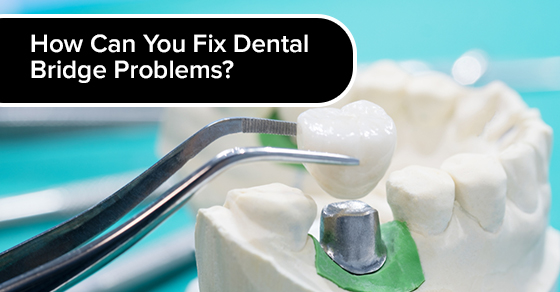
A dental bridge is a wonderful solution to lost teeth. It will return your life back to normal after losing some teeth. You’ll be able to eat with ease, speak, and be intimate without feeling uncomfortable or even embarrassed.
Before implants and veneers were developed, bridges were used on all teeth, including front teeth. Today, for the most part, bridges are used to replace molars. Implants and veneers are often better for front teeth, particularly from a cosmetic point of view.
If your bridge precision-made and fitted with care by your dentist, it’s likely that it will give you years of satisfaction. You’ll be able to speak clearly and eating will be just as it was before you lost the teeth. You’ll feel comfortable and confident kissing and being close when you want.
Despite the best technology and a dentist’s skilled and caring hands, bridges can still occasionally cause the dental bridge problems.
A bridge is fixed in your mouth, so you can’t remove it to clean it. There are some particular things that will cause dental bridge issues. Most of them can be avoided, particularly if you clean carefully on and around your bridge, and report any issues, such as loose fit, to your dentist.
Let’s take a look at the problems that can occur with dental bridges and how, if possible, they can be fixed.
One of the main problems with bridges is food. Even though the particles are tiny, they can build up over time and cause dental bridge problems if not cleaned away immediately. Diligent cleaning with a quality brush, as well as flossing, will resolve this issue. When your bridge is new, be sure to speak to your dentist about what kind of brush to use, as well as your brushing technique.
Bridges should fit seamlessly against the gumline. If your bridge is new and does not seem to have a snug fit, return to your dentist for an adjustment. You and your dentist should ensure that your bridge is tight and comfortable and that you can eat with ease.
The second cause of food debris under your bridge will occur over time. This is because as years pass you will experience bone loss in the area where the teeth have been removed. This, in turn, will lead to your bridge becoming loose. You may not notice it at first, but eventually, that seamless line between your gum and bridge will reveal a small space and you may start to notice that something doesn’t feel right. Make a call to see your dentist immediately, and keep your regular checkup appointment – your dentist may notice your loose bridge well before you do.
Calculus, or tartar, is the name given to plaque that builds up on the teeth. This plaque hardens fairly quickly and can build up around the bridge and teeth. If the tartar is not cleaned off from the bridge, it can damage the appliance and also cause bleeding around the gums. If left, will lead to gum disease.
Some people get more calculus than others. So if you’re one of those unlucky folks who is prone to it, discuss it with your dentists and reach out for solutions.
All dentists will tell you that the solution to calculus/tartar is good and regular oral hygiene. Properly brushing your bridge and teeth, and using floss or a proxy brush (micro-brush) to remove debris and plaque is essential. Do this at least once a day, but ideally more often. At the end of your teeth cleaning session use a good quality antiseptic mouthwash to take care of any tiny micro-pieces of bacteria that may have been left behind.
Most dentists can’t overemphasize cleaning your teeth too much. It’s really important because not doing so will lead to bits of food and bacteria building up in your mouth. This will quickly lead to tartar, bad breath, gum disease, and tooth decay. Ultimately, you could be looking at the loss of more teeth!
Having a dental bridge is similar to wearing braces in one way – you’ll need to stay away from hard foods. Even raw carrots, nuts, or super fresh broccoli could damage your bridge. If you’re a big fan of fresh veg, cut it into smaller pieces and only chew on the side without your bridge. Otherwise, give these hard foods a miss.
If you’re unfortunate enough to damage or fully break your bridge, you probably already know the next step to take – make a call to your dentist and ask for an emergency appointment. In the meantime, be sure to clean carefully and regularly around the bridge and the surrounding teeth until you arrive in the dentist’s chair.
We’ve touched on the key dental bridge problems and outlined the main solutions. As repetitive as it sounds, cleaning and flossing two or three times a day is the number one piece of advice to people with bridges – and non-bridge wearers, too!
Let’s quickly review the other important things that will help keep your bridge and your teeth in top shape for years to come!
If you have lost teeth and want to look at a dental bridge as a solution or have a dental bride problem, Oakville Place Dental Office is ready to help you. Contact us for a consultation and let us tell you what we can do for you today!
 0 Comment
0 Comment